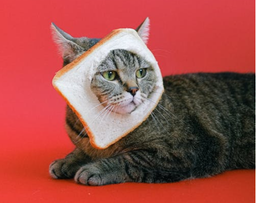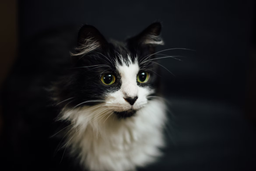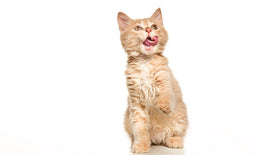Can cats eat broccoli, or will it turn them green?
Broccoli may not win a popularity poll any time soon, but it’s one of the healthiest veggies out there. This leafy green is quite a superfood with high amounts of dietary fibre and oxidants. The question is can cats eat broccoli, or are they immune to its nutritional qualities?
Let’s discuss what happens when your kitten eats broccoli and address the common dilemmas about feline nutrition. Find out which ingredients make the perfect meal and which iffy foods should be locked away in the pantry!
Can my cat eat broccoli?
Yes, broccoli is entirely cat-safe, so your pet can try it if they show an interest. The cruciferous vegetable is rich in:
- Fibre
- Vitamin C
- Vitamin K
- Iron
- Potassium
Broccoli has approximately two grams of soluble fibre, a complex carbohydrate that can promote digestion. According to some vets, if your pet has chronic gastrointestinal problems, the veggie can act as a natural probiotic and ease the discomfort.
Soluble fibre facilitates the growth of good bacteria in the intestines. When given in moderation, broccoli is supposed to help with constipation, hairballs, and acute stomach pain.
The vitamins and minerals in leafy veggies may also be beneficial in small amounts. Keep in mind that your pet already gets bioavailable micronutrients from cat food, so you shouldn’t over supplement their diet. Broccoli has a high vitamin C content (165%), so you should feed it in limited quantities. Too much vitamin C can contribute to the formation of bladder stones in cats, particularly those prone to urinary inflammations.

You can let your cat eat broccoli but in moderation!
Source: @its_all_about_kitties
What if my kitten eats broccoli?
On the off-chance your kitten loves broccoli, you can serve it as a treat after they finish weaning. If they’re still in the nursing period, giving them solid food will upset their stomach.
In the first three to four weeks, kittens only need breast milk for nourishment. In the absence of the litter queen, specially formulated milk replacers (KMR) will do the trick.
Do not give them regular milk since it’s too fatty. Most kitties become lactose intolerant later in life. Plant-based milk, such as soya and almond, is also problematic because of the high calorie content.
A steady diet of KMR and water is enough to sustain your kitten until they’re old enough to feed independently. You can then start with regular servings of kitten food and add various treats to their meal plan.
It’s safe to feed your kitten broccoli, spinach, lettuce, and other cat-safe veggies from time to time, but nothing tops healthy meat and fish, so stick to:
- Chicken
- Turkey
- Liver
- Lean deli meat
- Salmon
- Tuna
- Sardine
- Mackerel
- Prawns
- Shrimp
How to prepare broccoli for your cat
You could give your cat fresh broccoli, but there’s a slight chance it contains toxic substances. Depending on where you got it from, the veggie could have pesticide residue. Even a trace of insecticides, slug baits, and other pest-control products are potentially lethal to cats.
Cook the broccoli in plain, unseasoned water (no salt, no herbs, no spices). Here’s a breakdown of the process:
- Fill a pot or a deep pan with water and bring it to a boil
- Cut the broccoli into bite-sized pieces. Don’t use the stem, only the florets
- Put the broccoli in the boiling water and cook for three to four minutes. Don’t overcook the vegetable because it might start to smell
- Drain the water and leave the broccoli to cool off
How much fruit and veggies can cats eat?
Your cat isn’t suited for vegetarian meals because felines are completely adapted to a carnivorous diet, so they have limited ability to process carbs. Their glucose regulation is poor because they have low glucokinase activity in the liver and pancreas.
Cats who eat a lot of sugary foods, like sweet potatoes, corn, brown rice, and grains, are more likely to become hyperglycemic. A high-carb diet is also linked to feline obesity since the excess nutrients create a calorie surplus.
Compared to other fruits and veggies, broccoli isn’t too sweet, but it has a substantial amount of fibre. Too much soluble fibre in your cat’s meals can lead to chronic dehydration since it absorbs water from the digestive system. Overall, carbohydrates should be kept below 3% in your pet’s diet.
What’s the most nourishing food for felines?

Soo…what’s for dinner?
Source: @kubi.piku.catlife
Home cooking may sound like the healthiest option for your cat, but it’s often challenging to get the right nutrient ratio. Commercial cat food is the best choice for indoor cats because it provides all essential nutrients they would harness from freshly killed prey.
Your pet needs meat-based, well-balanced meals, with loads of:
- Moisture—Water enables blood circulation, digestion, reproductive and urinary function, as well as nutrient absorption
- Protein—It is your cat’s primary energy source, responsible for all vital bodily functions and amino acid (particularly taurine) synthesis. Cats can only harness it from animal tissue, meaning plant protein has low bioavailability for felines
- Fatty acids—The omega-3 and omega-6 fatty acids in poultry and fish keep your cat’s skin and fur shiny, preventing inflammations and supporting wound regeneration
Which type of cat food has a better nutrient ratio? Dry and wet formulas are both based on meat, but the exact ingredients list varies. Kibble is much more caloric since it contains iffy fillers, which increase the percentage of carbs.
While dry products are entirely safe and digestible, they’re best served as an addition to moist meals. Wet food typically has:
- 70% water
- More than 50% animal protein
- Low carb content
- Various bioavailable minerals and vitamins
Wet products also come in different textures, which can be helpful. If you have a fickle eater that prefers to chew on biscuits—switch from gravy to jelly wet food to awaken their curiosity and appetite.
Untamed will “rocc” your cat’s world
Untamed food was designed in collaboration with vets to ensure your cat gets everything they need in a single serving. Our recipes are entirely free from grain fillers, plant-based protein, animal derivatives, and other useless junk. Instead, each product is:
- High in protein—Untamed food delivers two times more animal protein than other commercially available products
- Made with whole meat—The meat cuts we use are of human-grade quality, packed with bioavailable nutrients
- Ethically produced—Being 100% Carbon Neutral Certified, we make sure our ingredients are sustainably caught
- Impossible to resist—Fussy eaters don’t stand a chance against our delicious and nourishing recipes
After switching their furry friends to Untamed’s all-natural diet, our clients have reported numerous health benefits! Within a few weeks, your kitty will have a tidier litter tray and experience an energy boost. The long-term perks of our feline delicacies include fewer hairballs, a shinier coat, improved weight management, and overall stable health.

Is the smelly green stuff gone? Good, now hand over the canned goods!
Image (c) Untamed
We’ll help you select the purrfect menu for your cat!
If you become a member of our wild bunch, you’ll get a chance to create a customised menu for your cat. Fill out our online questionnaire and choose from a wide range of delicious tuna and chicken recipes, including:
|
Our menu |
Details |
|
Chocka Chicken in Jelly* |
High-quality chicken breast soaked in mouth-watering jelly |
|
Chocka Chicken with Duck in Jelly |
Delicious chicken spiced up with rich duck meat, served in jelly |
|
Chocka Chicken with Ham in Gravy |
Tender chicken breast gently cooked in natural gravy with a hint of ham |
|
Chocka Chicken in Gravy* |
Shredded chicken meat simmered in thick gravy |
|
Tuck-in Tuna in Jelly* |
Prime cuts of tuna steak prepared in jelly and appetising fish broth |
|
Tuck-in Tuna with Salmon in Jelly |
Tuna steak and high-quality salmon fillet simmered in light jelly |
|
Tuck-in Tuna with Shrimp in Jelly |
Dolphin-safe tuna and delicious shrimp served in natural jelly |
*If you have an allergy-prone pet, don’t miss out on our single-source-protein recipes—Chocka Chicken in Jelly and Tuck-in Tuna in Jelly!

Chocka Chicken in Jelly is a signature Untamed product, wildly popular in our clowder!
Image (c) Untamed
How to sign up for a customised meal box
It only takes a few simple steps to become a member of our cat-loving community! To get your first tailor-made meal box, all you should do is:
- Visit our TRY NOW page
- Tell us about your cat’s food preferences, sensitivities, and life stage
- Pick a meal plan
- Place your cat food order online
You won't have to wait to get the goods. We'll send you a fresh Untamed meal box the next day! Following the starter pack, you can receive monthly cat food supplies—home-delivered and packed in 100% recyclable materials.
Are there more cat-friendly fruits and veggies?
If you’d like to know which high-fibre fruits and veggies are cat-friendly, check out the table below:
|
Fruit or veggie |
Fibre per 100 grams |
|
2.8 g |
|
|
2.6 g |
|
|
2.7 g |
|
|
2.4 g |
|
|
2.4 g |
|
|
2 g |
|
|
2 g |
|
|
Asparagus |
1.8 g |
Which fruits and veggies are toxic to cats?

What? What’s wrong? I’m just looking!
Source: @cica_queen
Some healthy human foods are potentially harmful to felines, so be careful with your choice of veggie treats. Make sure your pet doesn’t eat the following fruits and vegetables:
- Grapes—Grapes can cause acute kidney disease in cats, although scientists still don’t know why. It could be the effect of a particular toxin also found in cereals, nuts, dried fruits, and coffee beans or high levels of tartaric acid. Whatever it is, your cat should stay away from grapes and raisins, or they may experience vomiting and diarrhoea or (in more severe cases) kidney failure
- Citrus fruits—The essential oils and citric acid can cause food poisoning in felines. Your cat will likely experience bouts of vomiting and diarrhoea, accompanied by drooling, muscle tremors, and lethargy. The limonene and linalool concentration in the citrus peel can even provoke skin inflammations in more sensitive breeds (e.g. Burmese and Siamese)
- Allium vegetables—Allium plants, like garlic and onions, contain oxidants that accelerate the destruction of red blood cells. When given regularly, even tiny amounts of garlic powder can contribute to the onset of Heinz Body anaemia in felines. Besides allium veggies, kale is another unwanted ingredient in homemade soup or broth because it affects erythrocytes
Check out our other guides to what cats can or cannot eat:
|
|

![Best food for Ragdoll cats in the UK [Broken Down]](http://untamed.com/cdn/shop/articles/featured_best_food_for_ragdoll_cats_uk.jpg?v=1646818249&width=256)

